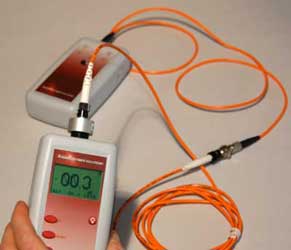A advanced optical fibre diameter analyser supports fibre manufacturing.
Exploring the Advantages of Optical Fiber Examining for Improved Interaction Equipments
The relevance of optical fibre screening in contemporary interaction systems can not be overstated, as it offers as a structure for making sure network integrity and efficiency. Making use of sophisticated methodologies such as Optical Time-Domain Reflectometry (OTDR) and insertion loss evaluation, organizations can not only determine mistakes but additionally optimize their setups. This aggressive screening technique has profound effects for signal top quality and functional efficiency, increasing the inquiry of how these methods add to lasting sustainability in an ever-evolving technical landscape. Comprehending these dynamics is crucial for stakeholders aiming to preserve a competitive side.
Importance of Optical Fibre Screening
The relevance of optical fiber testing can not be overemphasized in today's data-driven setting. As organizations significantly depend on high-speed data transmission for day-to-day operations, the honesty and efficiency of optical fiber networks are extremely important. Examining makes certain that these networks can support the huge quantities of information produced and transmitted seamlessly, promoting efficient interaction and connection.
Optical fibre screening offers several crucial functions, including verifying installment high quality, identifying potential faults, and figuring out total system efficiency. Regular screening can avoid costly downtimes and service disturbances, permitting organizations to preserve functional continuity. Furthermore, it helps in conformity with industry requirements and policies, ensuring that fibre optic installments fulfill called for requirements for security and dependability.
Furthermore, testing can enhance the long life of fibre optic systems. By proactively identifying concerns such as signal loss, attenuation, or port failures, organizations can attend to problems before they intensify, thus prolonging the life of their framework. In summary, optical fiber testing is not just a technological demand but a tactical investment that boosts network integrity, maximizes performance, and ultimately sustains the development and performance of contemporary interaction systems.
Secret Evaluating Techniques

OTDR is a vital method utilized to identify faults, step splice losses, and examine the general integrity of a fiber optic web link. By sending out a pulse of light down the fiber and analyzing the shown light, specialists can determine places of faults and examine the network's performance over long distances.
Insertion loss testing gauges the quantity of signal loss that takes place when light go through a connection or splice. This technique is important for confirming that links fulfill specific loss limits, which is essential for preserving optimal performance in communication systems.
Optical return loss testing quantifies the amount of light mirrored back in the Read Full Report direction of the resource because of blemishes in the fiber or connections. High return loss worths show better performance and minimized signal degradation.
Together, these testing techniques offer a comprehensive evaluation of fibre optic networks, ensuring their reliability and performance in varied interaction applications.
Impact on System Efficiency
Reliable optical fiber screening straight influences the total performance of interaction systems. By making certain the honesty of fibre optic wires, screening recognizes possible mistakes such as depletion, splice loss, and connector misalignment. These concerns can significantly deteriorate signal high quality, bring about interruptions and lowered information transmission rates.
Additionally, regular optical fibre screening contributes to long-lasting system sustainability. It allows early detection of wear and tear, enabling timely upkeep and upgrades prior to significant failings occur. This not only lengthens the life-span of the facilities but also ensures that communication systems remain competitive in terms of efficiency.
Cost-Effectiveness and Efficiency
Cost-effectiveness is an important factor to consider in the release and maintenance of optical fibre networks. Executing durable optical fibre testing treatments can substantially reduce operational prices by recognizing concerns prior to they escalate into significant problems. ofda. By finding faults, attenuation, and various other performance barriers early, organizations can stay clear of pricey repair services and downtime, which can disrupt solutions and bring about profits loss
Moreover, efficient testing methodologies improve the installation process, permitting service technicians to function much more properly. This equates to reduce work expenses and faster project completion times. Advanced screening tools, such as Optical Time Domain Reflectometers (OTDRs), enables a precise assessment of fibre high quality, ensuring that just special info optimum materials are used, consequently reducing waste.
Routine testing also adds to better source allowance. published here By recognizing the network's efficiency, companies can make informed choices about upgrades and expansions, ensuring that investments are made where they are most required. In recap, optical fibre testing improves cost-effectiveness and effectiveness, supporting the long-lasting sustainability and competition of communication systems in a significantly demanding market.
Ensuring Long-Term Integrity
Applying strenuous optical fibre testing not only boosts expense financial savings and operational efficiency but likewise plays an essential function in making sure the long-term integrity of interaction networks. Constant testing techniques, consisting of attenuation and data transfer assessments, aid recognize possible deterioration in fibre performance before it results in service disruptions.
By utilizing advanced screening approaches, network drivers can pinpoint mistakes or weaknesses in the fiber infrastructure, permitting for prompt remediation. This proactive technique minimizes downtime, ensuring that communication systems continue to be practical and efficient. Moreover, routine screening adds to the development of an extra durable network, as drivers can adapt and optimize their facilities based on real-time data understandings. robotic vision.
In addition, ensuring compliance with industry standards through optical fibre testing enhances the quality and stability of the entire communication system. This adherence not only strengthens confidence amongst stakeholders yet likewise straightens with governing needs, which are progressively strict.
Verdict
In conclusion, optical fiber testing functions as an essential element in improving communication systems. By utilizing different screening methods, such as OTDR and insertion loss analyses, networks can achieve optimal efficiency and dependability. The proactive identification of faults not only improves signal top quality but additionally decreases downtime, inevitably adding to cost-effectiveness and operational efficiency. Furthermore, adherence to market criteria promotes stakeholder self-confidence, ensuring the long-term sustainability of communication infrastructures in a significantly data-driven landscape.